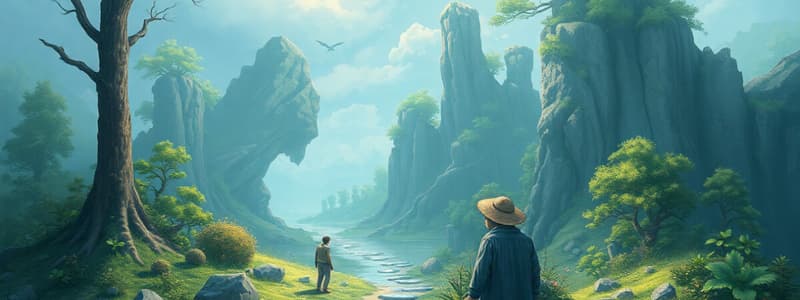Podcast
Questions and Answers
What two types of components make up an ecosystem?
What two types of components make up an ecosystem?
Biotic and abiotic components.
Name three abiotic components of an ecosystem.
Name three abiotic components of an ecosystem.
Temperature, rainfall, wind, soil or minerals.
What are living organisms and non-living constituents of the environment together called?
What are living organisms and non-living constituents of the environment together called?
An ecosystem.
Give an example of a natural ecosystem.
Give an example of a natural ecosystem.
Give an example of a human-made ecosystem.
Give an example of a human-made ecosystem.
Name two things that fish need in an aquarium.
Name two things that fish need in an aquarium.
What is a device that can be used to provide oxygen in an aquarium?
What is a device that can be used to provide oxygen in an aquarium?
What do all the interacting organisms and their physical surrounding in an area form?
What do all the interacting organisms and their physical surrounding in an area form?
How might the abiotic conditions of an garden ecosystem affect the biotic components?
How might the abiotic conditions of an garden ecosystem affect the biotic components?
Define abiotic.
Define abiotic.
In the context of an ecosystem, what distinguishes biotic components from abiotic components?
In the context of an ecosystem, what distinguishes biotic components from abiotic components?
How do organisms maintain balance in nature?
How do organisms maintain balance in nature?
Provide an example illustrating the interaction between biotic and abiotic components within a garden ecosystem.
Provide an example illustrating the interaction between biotic and abiotic components within a garden ecosystem.
Contrast natural and artificial ecosystems, providing an example of each from the text.
Contrast natural and artificial ecosystems, providing an example of each from the text.
What are the essential considerations for creating a balanced aquarium ecosystem?
What are the essential considerations for creating a balanced aquarium ecosystem?
Explain how an aquarium exemplifies a simplified ecosystem.
Explain how an aquarium exemplifies a simplified ecosystem.
How is the health of an ecosystem linked to the interaction between its biotic and abiotic components?
How is the health of an ecosystem linked to the interaction between its biotic and abiotic components?
In what ways does human activity commonly influence the balance within natural ecosystems?
In what ways does human activity commonly influence the balance within natural ecosystems?
Why is it important to consider both biotic and abiotic factors when studying an environment?
Why is it important to consider both biotic and abiotic factors when studying an environment?
Describe one way humans deliberately manipulate abiotic factors in an artificial ecosystem like a crop field and why?
Describe one way humans deliberately manipulate abiotic factors in an artificial ecosystem like a crop field and why?
Flashcards
Environment
Environment
The surroundings where organisms live and interact.
Ecosystem
Ecosystem
A community of living organisms and their physical environment interacting together.
Biotic components
Biotic components
Living organisms within an ecosystem, like plants and animals.
Abiotic components
Abiotic components
Signup and view all the flashcards
Natural ecosystem
Natural ecosystem
Signup and view all the flashcards
Human-made ecosystem
Human-made ecosystem
Signup and view all the flashcards
Interaction in ecosystems
Interaction in ecosystems
Signup and view all the flashcards
Aquarium components
Aquarium components
Signup and view all the flashcards
Ecosystem balance
Ecosystem balance
Signup and view all the flashcards
Global environmental issues
Global environmental issues
Signup and view all the flashcards
Components of an ecosystem
Components of an ecosystem
Signup and view all the flashcards
Biotic interactions
Biotic interactions
Signup and view all the flashcards
Abiotic factors
Abiotic factors
Signup and view all the flashcards
Types of ecosystems
Types of ecosystems
Signup and view all the flashcards
Garden as an ecosystem
Garden as an ecosystem
Signup and view all the flashcards
Examples of natural ecosystems
Examples of natural ecosystems
Signup and view all the flashcards
Human-made ecosystem examples
Human-made ecosystem examples
Signup and view all the flashcards
Aquarium essentials
Aquarium essentials
Signup and view all the flashcards
Role of abiotic components
Role of abiotic components
Signup and view all the flashcards
Examples of abiotic components
Examples of abiotic components
Signup and view all the flashcards
Study Notes
Chapter 13: Our Environment
- The term "environment" is frequently used in media and discussions.
- Developed and developing countries address environmental issues.
- Components in the environment interact.
- Human impact on the environment is discussed.
13.1 Eco-System: What are its Components?
- Organisms (plants, animals, microorganisms, humans) interact with their physical surroundings.
- A balanced ecosystem involves interacting organisms and non-living components (abiotic factors).
- Abiotic factors include temperature, rainfall, wind, soil, and minerals.
- Biotic components are living organisms, and their interactions influence ecosystem function.
- Examples of components in a garden ecosystem include plants (grasses, trees, flowers, rose, jasmine, sunflower), animals (frogs, insects, birds), and the physical environment.
- Ecosystems encompass various environments, including forests, ponds, lakes, gardens, and crop fields.
- Human-made ecosystems (e.g., gardens, crop fields) are contrasted with natural ecosystems (e.g., forests, ponds).
- Ecosystems can have different plants, animals, and their interactions affect their growth, reproduction, and other activities.
Activity 13.1
- Designing an aquarium involves considering space, water, oxygen, and food for fish.
- Oxygen can be provided by an oxygen pump (aerator).
- Fish food is a necessary element in an aquarium.
Studying That Suits You
Use AI to generate personalized quizzes and flashcards to suit your learning preferences.




